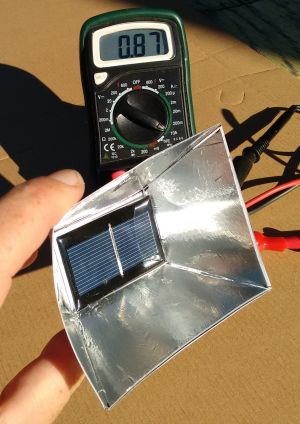The New Solar Cell Classroom Set (#SCS4)

Solar Schoolhouse makes Solar Cell Classroom Sets for hands-on explorations of solar power and electricity. In 2021 we’ve updated the contents to allow for more projects – including the Solar Carnival, Whirlygigs, Solar Spin Art, Solar Music Challenge, and Solar Village Projects. There are several student exercises for developing an understanding of basic electric theory and the photovoltaic effect. There are also troubleshooting tips and suggestions for repairing solar cells. Activities using the Solar Schoolhouse Solar Cell Classroom Set range from qualitative to quantitative experiences. Solar cells can be used with kindergarten classes to experience the photovoltaic effect (sunlight makes the motor spin) or with colleges and trade schools to plot the IV curves of solar modules. Students can build simple circuits to power a variety of electrical loads. Radios, motors, kinetic sculptures, and model homes can be powered with the Solar Cell Classroom Set.
There are 2 sizes of Solar Cell Classroom Set available. The Primary difference is the quantities of solar cells/motors etc to serve different class size. See the chart below.

Visit the Solar Schoolhouse Store to purchase a Solar Cell Classroom Set
Solar Cell Explorations
Solar Cells are a fun way to learn about basic electrical circuits. One can engage students in a variety of activities in a Qualitative manner using observation as the method of assessment. If your class has a set of Digital Multi-meters, you can also measure volts & amps in a variety of scenarios, to gain a greater understanding of how solar cells work.
Qualitative Solar Cell Exploration
- Simple Solar Circuits Worksheet with step by step approach for evaluating simple solar circuits. Requires 2 solar cells, 1 motor, and a propeller fan or wheel, for each student team. Have students write their observations in their journals. [PDF]
- As a 2nd Design Challenge give each student team one Sound Module with wires. The Sound Module (aka music chip) is typically found in a musical greeting card and powered by a battery. The students must figure out what configuration of the 2 solar cells will make it sing.
Quantitative Solar Cell Exploration
- Using the Digital Multi-Meter to evaluate solar cell performance, quantify power characteristics of series and parallel circuits, study the behavior of volts and amps under varied conditions, and troubleshooting simple solar circuits. The first step is to lean how to use a Digital Multi-meter with solar cell circuits [video tutorial], and using a worksheet to evaluate several combinations using 2 solar cells, 1 motor, and a propeller fan. [PDF] Requires a DMM (Digital Multi-meter)
Video Tutorials for Solar Circuits

Simple Solar Circuits (5 min)
Electrical Terminology (6 min 23 s)
AC DC Electricity (3 min)
PV (Solar) Cell Structure (4m 40s)
Using a Digital Multi-meter for low-voltage solar circuits (9 min)
These videos can be used to introduce terminology and concepts. Additional video tutorials and stories can be found at our Solar Schoolhouse Youtube Channel.
Additional Resources for Project or Activity Extensions
.

The Magic of Solar Cells
Introducing Solar Cells to your class with The Magic of Solar Cells video and poster. This short video ( ~ 6 minutes) helps introduce the history of solar cells (aka photovoltaics) and their many uses around the world. The video can be a good starting point for your class to then segue into exploring solar circuits using the Solar Cell Classroom Set, and ultimately applying their knowledge to building a project such as a whirlygig, Solar Carnival Ride or Solar Spinart.
Students could pick an application of interest or randomly pick one, so that all the applications are researched. They would do a little more research, write up a short summary of what they found, and share out with the class. In this manner, students will gain a broader perspective on what this amazing technology can and is doing in our world, in addition to the hands-on experience.
Visit this page for additional teaching tips using the Magic of Solar Cells resource, including a deck of cards for distributing applications, an EdPuzzle version of the video with embedded questions for students, and more. A Magic Solar Cell Article Bank is available with vetted articles for students to peruse, as an option to searching on the internet.

Solar Carnival
Using the Solar Cells, motors, and yellow wheels found in the Solar Cell Classroom Set, students are invited to create their own Solar Carnival Ride. The ‘Rocket’ or ‘Swing’ Rides are moderately challenging and work well with these solar cells. You may need to drill some holes into the yellow wheels to utilize brass brads – this helps with dissembling the creations at the end of the project, so you’ll have them to use again the next school year. Visit the Solar Carnival Page to learn more. Scroll down the whole page to find tip sheets for building the different rides and see what other teachers have done with this project. We’ve also created a specific ‘student’ solar carnival page where you can direct students to find resources.

Solar Spinart
Solar Spinart – The solar cells, motor, and yellow wheel in the Classroom Set can be used to create Solar Spinart. This is an inexpensive way to add another artistic element to your solar explorations. Using a small pvc coupling with a notch cut out at the bottom to hold the motor upright, plus some double-sided tape and felt-tip colored pens, are all that is needed. Click here for instructions. The Solar SpinArt page has more details along with templates for your use.

Solar Whirlygigs
Solar Whirlygigs are aka Solar kinetic sculptures. Making something move with solar power is a great way to both learn and teach about how solar cells work. Try to avoid using glue so you can reclaim the ingredients after project completion. Several whirlygig kits are shown here along with additional ideas for projects. To use the ingredients from the Classroom Set to power these creations, a simple approach is to use the brass fasteners to attach a cardboard circle to the wheel and motor. Then students can glue, tape, wire other decorations to the surface of their whirlygig creation, trying to balance everything so that it spins and doesn’t tip over. The pvc motor mounts in the Classroom Set can be placed in a small cardboard box for additional stability, or you can challenge your students to engineer additional support using various materials you provide, without using glue. This might include cardboard scrap or small cardboard boxes or other packaging material that would otherwise be thrown away or recycled. Since the solar cells are free-floating in this scenario, you might provide some wire ties for students to secure the solar cells to a cardboard support, or using tape on the back of the cells. Wire ties can also be made by cutting pieces of insulated solid wire (~ 20awg size).

Tips for Building Solar Circuits (click here to download printable pdf) posted 2017.06.08 This sheet could be given to students as a quick reference as they work through any solar circuit explorations or as they develop projects.

Reflection = more Power?
Creating a 4 sided reflector to increase Power output from the mini (0.5v*400mA) solar cell.
Template for making 4 sided reflector using metalic hvac tape as reflective material. [400kb pdf. 20160924 T.Allen]. One challenge for students, as they learn about volts and amps and solar cell dynamics, is to ask them to increase power output …without adding another solar cell! This 4-sided reflector ‘might’ just be a solution. but what is increased? volts, amps, or both? A digital multi-meter (there is one in the Classroom Set) will help answer this question.
Additional Resources
- Template and video tutorial for making a Sun Angle Quadrant Finder. The Quadrant is a useful tool for measuring tilt angles of solar cells during solar explorations.
- This one pager shows how to attach the Quadrant to a solar cell or module to determine the best tilt angle for best solar performance.
- Link to the Guide for the #SCS3 Solar Cell Classroom Set Solar Cell Classroom Set v.20090501 [6MB pdf]
Upgrade your #SCS3 Solar Cell Classroom Set to enable the new projects. Kit Price: $98 (see ingredients below. order via Store page)


